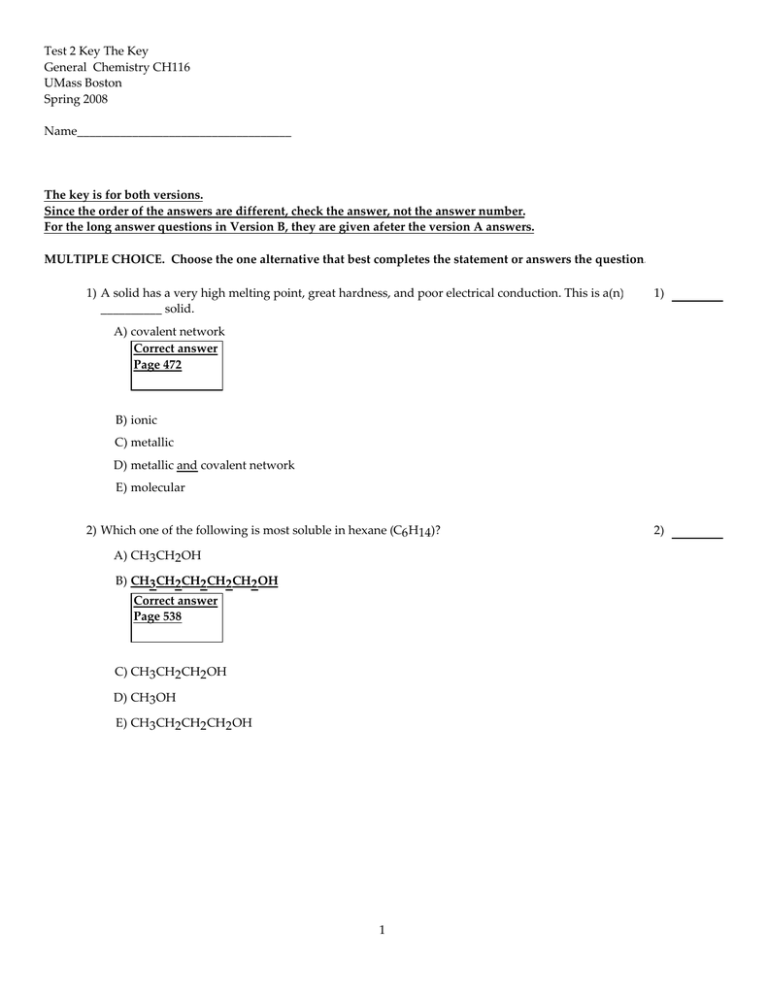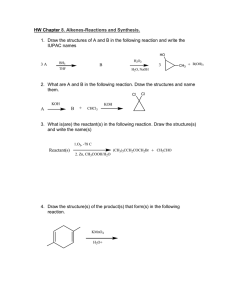Test 2 key Version A.tst
advertisement

Test 2 Key The Key General Chemistry CH116 UMass Boston Spring 2008 Name___________________________________ The key is for both versions. Since the order of the answers are different, check the answer, not the answer number. For the long answer questions in Version B, they are given afeter the version A answers. MULTIPLE CHOICE. Choose the one alternative that best completes the statement or answers the question. 1) A solid has a very high melting point, great hardness, and poor electrical conduction. This is a(n) __________ solid. 1) A) covalent network Correct answer Page 472 B) ionic C) metallic D) metallic and covalent network E) molecular 2) Which one of the following is most soluble in hexane (C6 H14)? A) CH3 CH2OH B) CH3 CH2CH2 CH2 CH2 OH Correct answer Page 538 C) CH3 CH2CH2 OH D) CH3 OH E) CH3 CH2CH2 CH2 OH 1 2) 3) Which of the following choices has the compounds correctly arranged in order of increasing solubility in water? (least soluble to most soluble) 3) A) CH4 < NaNO3 < CHCl3 B) LiF < NaNO3 < CHCl3 C) CH3 OH < Cl4 < CHCl3 D) CH3 OH < CH4 < LiF E) CCl4 < CHCl3 < NaNO3 Correct answer most non polar is CCl 3 , CHCl3 is polar NaNO3 is ionic. 4) The concentration of nitrate ion in a solution that contains 0.900 M aluminum nitrate is __________ M. 4) A) 2.70 you need to know Al (NO3)3 CH 115 B) 0.900 C) 0.300 D) 0.450 E) 1.80 5) A saturated solution __________. 5) A) contains no double bonds B) cannot be attained C) contains as much solvent as it can hold D) contains dissolved solute in equilibrium with undissolved solid Page 536 E) will rapidly precipitate if a seed crystal is added 2 6) Which of the following liquids will have the lowest freezing point? 6) A) pure H2 O B) aqueous glucose (0.60 m) C) aqueous FeI3 (0.24 m) 0.72 m concentration of solute particles. D) aqueous KF (0.50 m) Correct answer 1.0 m concentration of solute particles. E) aqueous sucrose (0.60 m) 7) Which one of the following is not a valid expression for the rate of the reaction below? 7) 4NH3 + 7O2 → 4NO2 + 6H2 O A) B) 1 Δ[NO2 ] 4 Δt C) D) 1 Δ[NH3 ] 4 Δt 1 Δ[O2 ] 7 Δt 1 Δ[H2O] Δt 6 E) All of the above are valid expressions of the reaction rate. 8) The rate law of a reaction is rate = k[D][X]. The units of the rate constant are __________. A) mol L-1 s-2 B) mol L-1 s-1 C) L2 mol-2s-1 D) L mol-1 s-1 Correct Answer Page 585 k= rate/ [D][X]= E) mol2 L-2s-1 3 8) The data in the table below were obtained for the reaction: 2 ClO2 (aq) + 2 OH- (aq) → ClO3 - (aq) + ClO2 - (aq) + H2 O (1) Experiment Initial Rate Number [ClO2 ] (M) [OH- ] (M) (M/s) 1 0.060 0.030 0.0248 2 0.020 0.030 0.00276 3 0.020 0.090 0.00828 9) What is the overall order of the reaction? 9) A) 1 B) 0 C) 2 D) 4 E) 3 The reaction is First order with respect to OH- and second order with respact to ClO2 Overall reaction rate is 1+2=3 Page 586 The reaction A → B is first order in [A]. Consider the following data. time (s) [A] (M) 0.0 1.60 10.0 0.40 20.0 0.10 10) The half-life of this reaction is __________ s. 10) A) 3.0 B) 7.1 C) 0.14 D) 0.97 E) 5 Correct Answer Just read the table for [A]= 0.8M 11) A reaction was found to be third order in A. Increasing the concentration of A by a factor of 3 will cause the reaction rate to __________. A) decrease by a factor of the cube root of 3 B) increase by a factor of 9 C) triple D) increase by a factor of 27 Correct answer Page 586. E) remain constant 4 11) 12) At elevated temperatures, methylisonitrile (CH3NC) isomerizes to acetonitrile (CH3 CN): CH3 NC (g) → CH3CN (g) The reaction is first order in methylisonitrile. The attached graph shows data for the reaction obtained at 198.9°C. The rate constant for the reaction is __________ s-1 . A) -5.2 × 10-5 B) +6.2 C) +1.9 × 104 D) -1.9 × 104 E) +5.2 × 10-5 Correct Answer The slope of this line is -k, the rate constant . Page 589 5 12) 13) Nitrogen dioxide decomposes to nitric oxide and oxygen via the reaction: 2NO2 → 2NO + O2 In a particular experiment at 300°C, [NO2 ] drops from 0.0100 to 0.00650 M in 100 s. The rate of appearance of O2 for this period is __________ M/s. A) 7.0 × 10-3 B) 1.8 × 10-5 Correct answer Rate = change in concentrtion change in time = (0.0100-0.0065) M = 3 .5x 10 -5 M/s= Rate of disappearence of NO2 100 Rate of appearanceof Oxygen = 1 Rate of disappearence of x NO2 2 = 1.89x 10-5 C) 7.0 × 10-5 D) 3.5 × 10-5 E) 3.5 × 10-3 6 13) 14) A sample of potassium nitrate (49.0 g) is dissolved in 101 g of water at 100 °C, with precautions taken to avoid evaporation of any water. The solution is cooled to 30.0 °C and no precipitate is observed. This solution is __________. A) unsaturated B) placated C) supersaturated At 30 oC 100 g water can dissolve only 45 g KNO3 D) saturated E) hydrated 7 14) 15) 15) What chemical equation is consistant with the data given above: A) A--> 2C Correct answer As the key shows the wrong answer, and I failed to notice everone is getting the points for this question. B) A--> C C) C--> A D) C-->2A 8 SHORT ANSWER. Write the word or phrase that best completes each statement or answers the question. 16) What is the osmotic pressure (in atm) of a 0.040 M solution of a non-electrolyte at 30.0 oC? 16) 17) A solution contains 150.8 grams of NaCl in 678.3 grams of water. Calculate the vapor pressure lowering (in torr) of the solution at 25.0 oC. (Note: the vapor pressure of pure 17) water at 25.0 oC is 23.76 torr.) The Verssion B : 9 18) For the reaction aA + Bb → cC + dD the rate law is __________. 18) Rate =k[A]m[B]n 19) For the following reaction indicate how the rate of disapperance of each reactant is related to the rate of appearance of each product: 2N2 O (g) --> 2N2 (g) + O2(g) 10 19) 20) 20) Consider the above graph of the concentration of a substance over time. a. Is X a reactant or a product_________________________________ Product b. Why is the average rate of the reaction greater between 1 and 2 than between 2 and 3. Because the amoubnt of the reactant is reducing as the time goes by and the rate of the reaction is dependent on it. 11 ESSAY. Write your answer in the space provided or on a separate sheet of paper. 21) A solution of unknown nonvolatile electolite was prepared by dissolving 0.250 g of the substances in 40.0 g of CCl4 . The boiing point of the resultant solution was 0.357 oC higher than the pure solvent . Calculate the molar mass of the solute. Kb for CCl4 = 5.02oC/m 22) The decomposition of N2O5 in a solvent proceeds a s follows: 2N2 O5 --> 4NO2 + O2 The rate is first orderin N2 O5 . At 64oC the rate constant is 4.82 x 10 -3/s. (a) Write the rate law of the reaction. (b) What is the rate of the reaction when [N2 O5 ]= 0.0240 M For version B 12 (c) What happens to the rate of the when the concentration of N2 O5 is doubled to 0.0480M? Version B 13 Answer Key Testname: TEST 2 KEY VERSION A 1) A 2) B 3) E 4) A 5) D 6) D 7) E 8) D 9) E 10) E 11) D 12) C 13) B 14) C 15) B 16) 1.0 17) 2.85 18) k[A]m [B]n 19) 20) 21) 22) 14




